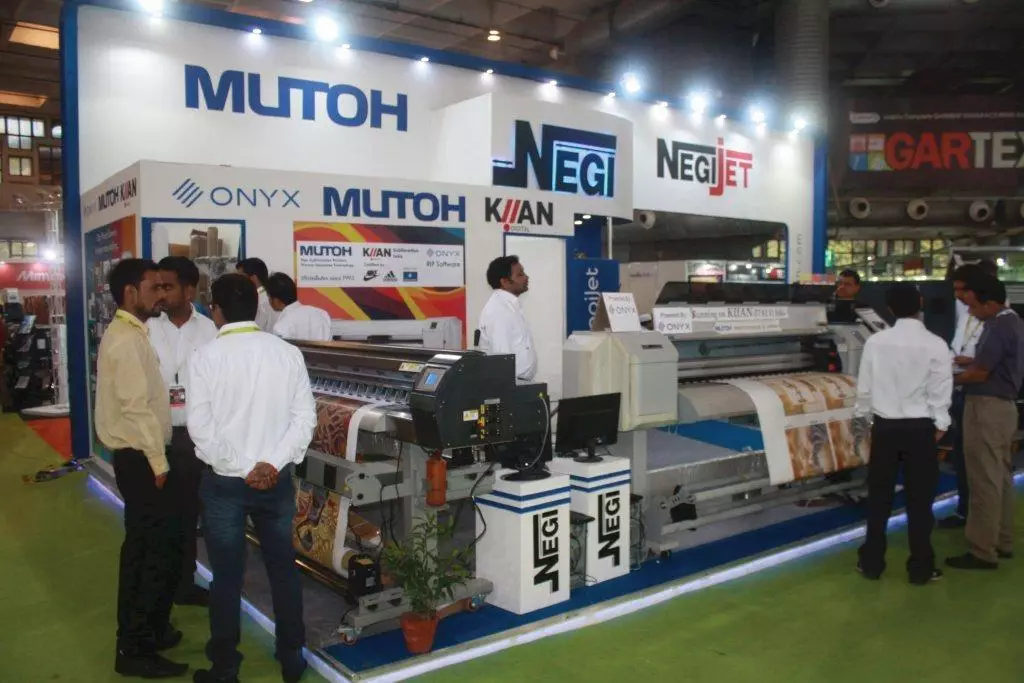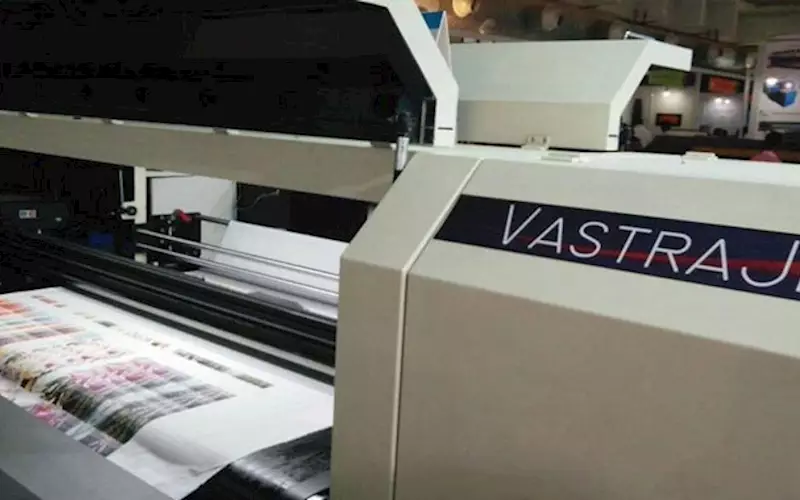Digital printing set to conquer growing textile printing market
Gartex 2016, a brand-new trade show, highlights the capability of digital printers in textile printing. Rahul Kumar reports from the ground.
29 Sep 2016 | By Rahul Kumar
As per estimations, the value of Indian textile printing market value is Rs 1,000 crore, and it is growing fast. You will find the evidence in your neighbourhood shopping mall. Perhaps the garments you are wearing are printed. Thus, it was no surprise when Bengaluru-based textile printing specialists Quenby Transfers claimed the PrintWeek India Company of the Year award in 2014.
India has a tradition of textile printing with the use of wooden blocks. You could find evidences of it in any handloom emporium. Machines for textile printing were introduced as early as 1834, with the perrotine block-printing machine. Since then all kinds of technologies have been used to print on textile – roller, cylinder, screen, heat transfer, dye sublimation and so on. Now, of course, the time is rife to shift to digital textile printing.
There are technologies from different manufacturers, yet the penetration of digital in textile printing is still low, just 1% or around Rs 10 crore of total value. The market is dominated by rotary screen printing.
This is what makes Gartex 2016, the first edition of the show important and interesting. Organised by MEX Exhibitions, Gartex offered a platform to the manufacturers of digital inkjet printers to come together and showcase their solutions. Thus, we have names like Apsom Infotex, Apsom Technologies, Arrow Digital, Epson India, Mimaki India, Monotech Systems, Negi Sign Systems and Supplies, Orange O Tec and Vee Kay Enterprises, among others.
In fact, digital textile printing was a special show within Gartex, titled Digitex. Other special focus shows were Fashion ‘Fabs’ Show, focused on fabrics, and TrimsExpo, focused on apparel accessories.
Held at Pragati Maidan in New Delhi from 27 to 29 August 2016, Gartex 2016 saw the participation of 66 exhibitors and 12,000 visitors. This was decidedly a boutique show, with dedicated visitors. The exhibitors were happy with the responses.
Unexplored market
For the manufacturers of digital wide format printers it is an unexplored market, and everyone is gearing up to explore the opportunities. Look how US giant EFI recently invested USD 140 mn in Italian textile ink and kit manufacturer Reggiani Macchine and Israeli wide-format manufacturer Matan, with a clear aim to tap this market. It also purchased Optitex, a 2D/3D fashion design and prototyping software developer.
Other players are equally gung-ho, and why not, there is a clear interest from the industry as well. At Gartex 2016, Epson closed orders of 15 units of the F series, including one unit of DTG. Epson has performed exceedingly well with its textile CAD having notched sales of four units with the T5270. All these sales are from NCR and Punjab. The key product at the show for Epson was the F9270 with a high-density black with a print engine speed of 99 sq/m per hour.
The Colorjet stall at the show, on the other hand, saw more than 500 curious visitors enquiring about digital textile printing machines. The Indian manufacturer showcased its VastraJet 1.8-metre wide digital kit which prints directly on cotton, polyester and blends. The USP of Colorjet machines is the low cost of ownership, which, according to the company, is because it markets its digital textile printers directly to the end-user.
At the show, Japanese manufacturer Mimaki launched its Tiger 1800B globally. It is a belt-type direct-to-textile inkjet printer high-speed range model. The maximum speed is 390 sq/m. The company also showcased its TX300P model of wide format printers.
Roland, which has an installation base of 50 kit in India, displayed its Texart dye sublimation printing press. Ahmedabad-based Arrow Digital, which represents EFI Reggianni and Jetrix among others, showcased the Mtex kit. Chennai’s Monotech displayed its industrial digital textile printers while Delhi’s Caldron Graphics showcased its wide format printers with production capacity up to 200 sq/m per hour in three passes. Caldron Graphics has its production facility in IMT Manesar.
Negi Sign Systems and Supplies displayed three printers – Mutoh RJ 900s and VJ 1624, and Negijet TX R-1900. Negi is the Indian representative of Belgium-based Mutoh.

The spread of textile printing
According to a report, the global digital textile printing market is valued approximately USD 7.5 billion. The worldwide digital textile printing market for garment, home décor and industrial applications is experiencing strong growth of around 34% CAGR to 2019.
According to a latest survey, the Asian region accounts for only 30% of the global digital textile printing market, with Europe garnering the largest market share of 45% and the Americas accounting for almost 20%. With the Asian market now supplying 60% of the traditional textile printing market, there are considerable opportunities for growth of digital textile print, particularly in Indian and Chinese markets.
Traditionally in India, after agriculture, the textile industry is the only industry that has generated huge employment for both skilled and unskilled employees. The industry continues to be the second largest employment-generating sector in India. It offers direct employment to over 35 million in the country.
Exhibitor speak
Sam Gulve, EFI
The textile printing is a 7.5 billion dollar market, and is projected to grow more than 34% worldwide, providing outstanding opportunities. The actual number should be much higher and the biggest impact shall be in India and China.
Tomohiro Ikeda, Mimaki India
India is a huge opportunity for us. We have sold 30 dye sublimation printers in the last six months. We want to give solutions and help our customers make money along with us. We have specific printers for specific applications. We want our customers to purchase entry-level printers initially and then go for high-end.
Manoj Kumar Garg, Monotech Systems
We represent Mimaki and Homer in textile segment, and we have our own brand Pixeljet. Digital textile printing market is in its nascent stage in the country and it has to go a long way. The technology is used for short run and specialised jobs in India. The print quality is good but expensive and the speed is slow compared to rotary screen printing.
Ajay Agarwal, Insight Communications
We represented Italian company La Meccanica, which Mimaki took over. Now, we represent Mimaki India for the textile and apparel and industrial printing segments for northern and western regions. We have sold 30 printers in a short span and could enter into Surat market, the biggest in India. Presently, we have machines that can print 200 sq/m an hour, but earlier the speed was 50 sq/m an hour. Thus, the technology and industry is changing.
Mukesh Kumar Jha, Apsom Infotex
Texart XT-640 is one of the prominent printers in the industry. Its seven droplet printheads cover all the details. It gives more choices with colour mode four and eight. New media feed system for non-shift printing, automatic bulk ink switching system and fluorescent printing capabilities give it an edge in the industry.
Digital textile printing in India
As per estimates, around 1,000 high-end digital printers are functioning for textile printing. It has made inroads into tier-II and III cities as well, as the initial cost of investment is economical. It has been projected that in three years, the number will grow up to 3000. The silk city of India, Surat, has 2,500 textile mills and out of those, only around 80 are using digital textile printing. So you can only imagine the possibility. The majority of digital printing on textiles is done on polyester fabrics using dye sublimation.
The suitable speed for the Indian market is 200 sq/m, but higher speed machines are also in demand. In future, single-pass technology will be in demand. Digital printing is suitable up to 15,000 to 20,000 sq/m. Above this, rotary screen is recommended.
Italian machines dominate the market. Recently, Mimaki bought Italian Lamacenica and EFI bought Reggiani Macchine. Epson has also strengthened its position in the industrial digital textile segment with the acquisition of Italian digital printer manufacturer Robustelli.
In numbers
Only 1% of textiles printed digitally
384 million metres of fabric printed digitally
2.5% or almost 75 million metres of fabric is printed with DTG
Revenue size is Rs 1,000 crore (including inks)
Ink consumption on an average is around 8-12gm/m with an annual ink consumption of 700-800 metric tonnes











 See All
See All